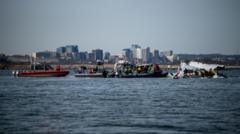Air traffic control staffing was described as "not normal" during the recent mid-air collision in Washington, DC, which resulted in the tragic deaths of 67 individuals, according to Transportation Secretary Sean Duffy. The collision occurred between an American Airlines passenger plane and a military Black Hawk helicopter, prompting scrutiny over the understaffed air traffic control tower at Reagan National Airport.
Reports indicate that at the time of the incident, just one air traffic controller was managing both helicopter and aircraft traffic, a duty typically divided between two personnel. This unusual staffing mix has led to serious safety concerns, with Duffy confirming that the Federal Aviation Administration (FAA) would be reviewed for its practices.
The national focus has narrowed in on how these staffing levels may have influenced the tragic outcome. Preliminary investigations by the National Transportation Safety Board (NTSB) revealed the helicopter was flying at 200 feet—right at the ceiling limit for helicopters in the busy airspace surrounding the airport.
Duffy expressed skepticism about why a military flight would occur during peak hours instead of opting for a later time with far less air traffic. "I want our military to be trained and ready to go, but I also want air travelers to be safe," he stated during a recent interview, emphasizing that the timing of such missions must be carefully considered.
The helicopter was conducting an annual training mission with seasoned pilots familiar with the area when it collided with the passenger plane, which had 64 people on board. Recovery operations in the Potomac River continue as officials work to locate the remaining victims.
Compounding the tragedy is the ongoing staffing crisis in U.S. air traffic control systems. Duffy noted that up to 90% of air traffic control facilities across the country operate below the recommended staffing levels, attributing this shortfall to chronic issues that stress existing staff, leading to burnout. He assured that he is collaborating with the FAA to implement training programs for new controllers.
As recovery teams work tirelessly, many families gathered near the crash scene, mourning the loss of their loved ones. DC Fire Chief John Donnelly stated they are hopeful of recovering all victims, navigating the complexities of the ongoing investigation. As the community grapples with this devastating incident, the focus remains on accountability, safety, and understanding the causes that led to this tragedy.


















